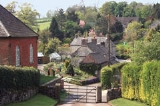
Kniveton
Encyclopedia
Kniveton is a village in Derbyshire
, England
. It is located in the Peak District
, 3 miles (4.8 km) north east of Ashbourne
, 6 south west from Wirksworth and 150 miles (241.4 km) from London. It is close to the reservoir at Carsington Water.
excavated one in 1845. A later excavation revealed a rivetted bronze dagger with an ivory pommel, an urn or food vessel, a perforated stone axe and an amber ring.
Kniveton is mentioned in the Domesday book where it is recorded as Cheniveton. The manor belonged to the Kniveton family. The manor was sold after 1660 to the Lowe family and afterwards to the Pegge family who sold it to the Meynells.
During the 19th century the inhabitants worked in the cotton mills. Lime-burning and agriculture were other occupations.
The coat of arms on display in the church's stained glass window is that of the Kniveton family.
The former Kniveton Methodist Church dates from 1832. It is built of red brick on a stone plinth with a tiled tipped roof. It is a GradeII Listed building.
Derbyshire
Derbyshire is a county in the East Midlands of England. A substantial portion of the Peak District National Park lies within Derbyshire. The northern part of Derbyshire overlaps with the Pennines, a famous chain of hills and mountains. The county contains within its boundary of approx...
, England
England
England is a country that is part of the United Kingdom. It shares land borders with Scotland to the north and Wales to the west; the Irish Sea is to the north west, the Celtic Sea to the south west, with the North Sea to the east and the English Channel to the south separating it from continental...
. It is located in the Peak District
Peak District
The Peak District is an upland area in central and northern England, lying mainly in northern Derbyshire, but also covering parts of Cheshire, Greater Manchester, Staffordshire, and South and West Yorkshire....
, 3 miles (4.8 km) north east of Ashbourne
Ashbourne, Derbyshire
Ashbourne is a small market town in the Derbyshire Dales, England. It has a population of 10,302.The town advertises itself as 'The Gateway to Dovedale'.- Local customs :...
, 6 south west from Wirksworth and 150 miles (241.4 km) from London. It is close to the reservoir at Carsington Water.
Toponymy
The name Kniveton derives from "Cengifu" and "tun", meaning the farmstead of a woman named Cengifu, an OE personal name.Early History
There are two scheduled barrows in Kniveton and Thomas BatemanThomas Bateman
Thomas Bateman was an English antiquary and barrow-digger.-Biography:Thomas Bateman was born in Rowsley, Derbyshire, England, the son of the amateur archaeologist William Bateman...
excavated one in 1845. A later excavation revealed a rivetted bronze dagger with an ivory pommel, an urn or food vessel, a perforated stone axe and an amber ring.
Kniveton is mentioned in the Domesday book where it is recorded as Cheniveton. The manor belonged to the Kniveton family. The manor was sold after 1660 to the Lowe family and afterwards to the Pegge family who sold it to the Meynells.
During the 19th century the inhabitants worked in the cotton mills. Lime-burning and agriculture were other occupations.
Governance
Historically Kniveton was a township, parish and village in the Western division of the county, part of the ancient Wirksworth hundred, and part of the Ashbourne Poor Law Union which came into existence in January 1845.The coat of arms on display in the church's stained glass window is that of the Kniveton family.
Geography
Kniveton covers 1974 acres (8 km²), the underlying rock is limestone and the soil is heavy, much of it pastureland.Population change
| Population growth in Clowne from 1881–1961 | |||||||||||
|---|---|---|---|---|---|---|---|---|---|---|---|
| Year | 1881 | 1891 | 1901 | 1911 | 1921 | 1931 | 1951 | 1961 | |||
| Population | 272 | 269 | 266 | 268 | 260 | 253 | 265 | 276 | |||
Kniveton Ch/CP/AP |
|||||||||||
Education
In 1715 Mr. John Hurd gave land for the endowment of a school at Kniveton. A church school was built in 1861. Today Kniveton CE Primary School serves the village and the surrounding rural community.Religion
The church in Kniveton was originally a chapelry to St Oswald's church in Ashbourne. St. Michael's church has Norman origins as evidenced in the plain semi-circular arch of the porch. It, is sited on a small hill, built of coursed rubble gritstone with ashlar dressings in the Early English style and dates from the I3th century, it consists of chancel, nave, south porch and a low embattled western tower with a short spire, the tower has two 17th century bells, one dated 1665. St Michael's Church is a Grade I Listed building.The former Kniveton Methodist Church dates from 1832. It is built of red brick on a stone plinth with a tiled tipped roof. It is a GradeII Listed building.

